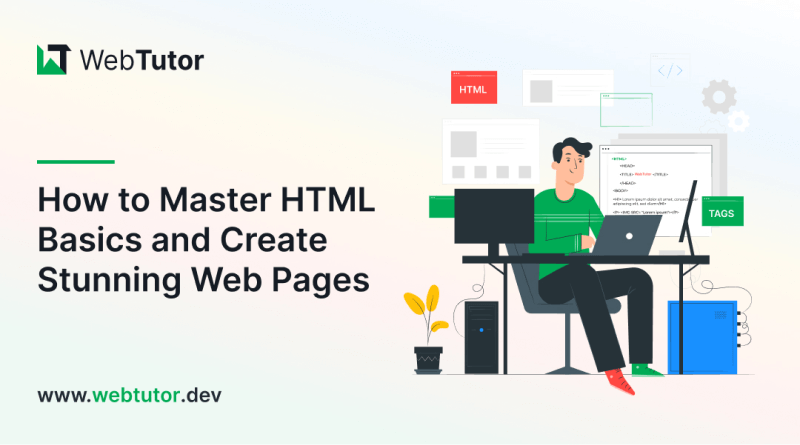If you're looking to establish an online presence, building your first website is an essential step. However, the thought of creating a website from scratch can seem overwhelming, especially if you're not familiar with HTML. But don't worry, mastering HTML basics is easier than you might think, especially when you can find a HTML tutorial for beginners online as per your suitability.
By understanding the fundamental principles of HTML, you can create stunning web pages that are both visually appealing and user-friendly. In this guide, we'll walk you through HTML basic structure, insert text, images, and links, and style your site with CSS.
Whether you're starting a blog, promoting a business, or showcasing your portfolio, learning HTML is a crucial skill for anyone looking to build a successful website. So, let's dive in and get started on building your first website!
Understanding HTML Basics
HTML, or Hypertext Markup Language, is the standard markup language used to create web pages. It is essential for creating the structure and content of web pages, including text, images, and links.
It uses tags to identify different types of content and structure within a web page. Tags are surrounded by angle brackets, and the content they encapsulate is placed between the opening and closing tags.
HTML is a simple language that consists of a few basic elements. These elements include the document type declaration, the html tag, the head tag, and the body tag.
The document type declaration tells the browser what version of HTML the document is using. The html tag defines the beginning and end of an HTML document. The header tag in HTML contains information about the document, such as the title, while the body tag contains the content of the document.
HTML Tags and Their Functions
HTML tags are used to define the structure and content of a web page. There are many different types of HTML tags, each with its own function. Some of the most commonly used HTML tags include heading tags, paragraph tags, image tags, and link tags.
- Heading tags are used to define the headings of a web page. There are six levels of heading tags, with h1 being the most important and h6 being the least important.
- Paragraph tags are used to define paragraphs of text. Image tags are used to insert images into a web page.
- Link tags are used to create hyperlinks between web pages.
HTML tags can also be used to define the layout of a web page. For example, the div tag is used to group together sections of a web page, while the span tag is used to define small sections of a web page. These tags can be used to write basic HTML code.
Basic Structure of an HTML Document
Every HTML document consists of two parts: the head and the body. The head contains information about the document, such as the title and any metadata, while the body contains the content of the document.
Here is an example of a basic HTML document structure:
In this example, the declaration tells the browser that the document is using HTML5. The html tag defines the beginning and end of the HTML document, while the head tag contains the title of the document. The body tag contains the content of the document, including a heading and a paragraph of text.
Creating Your First HTML Page
Creating your first HTML page is easy. All you need is a text editor and some basic knowledge of HTML.
To create a new HTML document, open your HTML online editor and create a new file. Save the file with a .html extension. Then, copy and paste the following code into the file:
Save the file and open it in your web browser. You should see a basic web page with a heading and a paragraph of text.
And that’s it!
You just created your first HTML website.
Adding Text and Images to Your HTML Page
To add text to your HTML page, use the paragraph tag. Enclose your text within the opening and closing paragraph tags, like this:
To add an image to your HTML page, use the image tag. The image tag requires a source attribute that specifies the location of the image file. Here is an example:
Creating Links and Anchor Tags
Links are an essential part of any website. They allow users to navigate between different pages and websites. To create a link, use the anchor tag. The anchor tag requires a href attribute that specifies the URL of the page or website you want to link to. Here is an example:
Understanding CSS and Its Role in Website Design
Any HTML tutorial is incomplete without mentioning CSS. CSS, or Cascading Style Sheets, is a style sheet language used to describe the presentation of a web page. CSS is used to control the layout, font, color, and other visual aspects of a web page.
CSS works by selecting HTML elements and applying styles to them. It can be applied to HTML elements using inline styles, internal styles, or external styles.
Inline styles are applied directly to an HTML element, while internal styles are defined within the head of an HTML document.
External styles are defined in a separate .css file and linked to the HTML document using the link tag.
Applying CSS Styles to Your HTML Page
To apply CSS styles to your HTML page, you need to select the HTML elements you want to style and define the styles you want to apply. Here's an example of how to apply a background color to the body of your HTML document:
This code selects the body element and applies a background color of #f2f2f2.
Building a Responsive Website with Media Queries
A responsive website is one that adapts to different screen sizes, such as those found on mobile phones and tablets. To create a responsive website, you can use media queries.
Media queries allow you to apply different styles to your HTML elements based on the screen size of the device being used to view your website.
Here's an example of a media query that applies a different font size to the body of your HTML document on smaller screens:
This code applies a font size of 16px to the body element when the screen size is 600px or smaller.
Tips for Optimizing Your Website for Search Engines
If we are talking about making websites, then we can’t leave SEO behind. Every developer must have at least a basic understanding of SEO.
Search engine optimization, or SEO, is the practice of optimizing your website to rank higher in search engine results pages.
Here are some tips for optimizing your website for search engines:
- Use relevant keywords in your page titles, headings, and content.
- Include descriptive alt tags for your images.
- Use descriptive anchor text for your links.
- Use a sitemap to help search engines crawl your website.
Testing and Launching Your Website
Before launching your website, it's essential to test it thoroughly to ensure that everything is working correctly. Test your website in different web browsers and on different devices to make sure it looks and functions as intended. Once you're satisfied with your website, it's time to launch it.
To launch your website, you'll need to find a web hosting provider and upload your HTML and CSS files to their server. You'll also need to register a domain name for your website.
Resources for Mastering HTML and Website Design
There are many resources available online for mastering HTML and website design. Every HTML tutorial has a factor that stands out for it.
Here are some of the best resources to get started:
- WebTutor: It is an online web development tutorial website that offers free and easy-to-understand lessons on web development technologies.
- W3Schools: A comprehensive online resource for learning HTML, CSS, and other web development technologies.
- Codecademy: An interactive online learning platform for learning HTML, CSS, and other programming languages.
- Udemy: An online learning platform that offers courses in HTML, CSS, and web design.
- Lynda: A subscription-based online learning platform that offers courses in HTML, CSS, and web design.
Conclusion
Building your first website may seem daunting, but with a basic understanding of HTML, you can create stunning web pages that are both visually appealing and user-friendly.
By understanding the structure and content of HTML, as well as the role of CSS in website design, you can create a website that stands out from the crowd.
With the resources available online, mastering HTML and website design has never been easier.
So, what are you waiting for? Start building your first website today!

